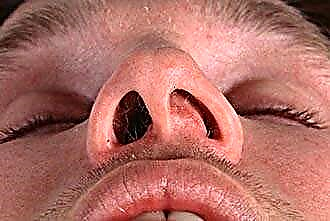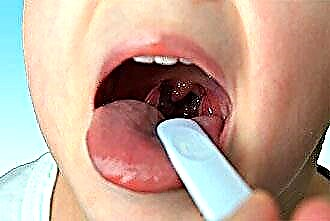Pharyngolaryngitis often develops as a complication of one of the diseases - inflammation of the oropharynx or larynx. However, in severe infections, several parts of the respiratory tract and ENT organs can be simultaneously affected. As the disease progresses, symptoms of bronchitis, rhinitis or otitis media appear. What is pharyngolaryngitis? This is a disease in which not only the throat becomes inflamed, but also the larynx. In adults, the pathology is much easier in comparison with childhood. Children have an increased risk of developing false croup, which is manifested by an attack of suffocation and severe respiratory failure.
Provoking factors
 Most cases of pharyngolaryngitis are caused by a viral infection of the body. The frequency of visits to the otolaryngologist increases with the onset of cold weather or dampness outside, especially during a flu epidemic. Inflammation of the lining of the oropharynx and larynx can accompany infections such as diphtheria, measles, scarlet fever, or whooping cough, but adenovirus infection or influenza is often diagnosed.
Most cases of pharyngolaryngitis are caused by a viral infection of the body. The frequency of visits to the otolaryngologist increases with the onset of cold weather or dampness outside, especially during a flu epidemic. Inflammation of the lining of the oropharynx and larynx can accompany infections such as diphtheria, measles, scarlet fever, or whooping cough, but adenovirus infection or influenza is often diagnosed.
Bacteria cause more severe intoxication than viruses. Its degree depends on the aggressiveness of the pathogen and the stability of the organism. Among bacterial agents, it is worth highlighting the influence of streptococci, staphylococci or pneumococci.
Infectious reasons also include fungal infection, when, under the influence of unfavorable factors, intensive reproduction of fungal pathogens begins.
With a normal level of immune defense conditionally pathogenic flora remains in a "dormant" form, without causing the development of the disease.
Usually, fungal activation occurs against the background of immunodeficiency, after taking large doses of antibacterial drugs or hormonal agents for a long course.
Infection is dangerous with a high risk of chronicity, which is due to untimely diagnosis and improper treatment of a fungal infection.
In addition to infectious causes, it is necessary to list various predisposing factors that contribute to the appearance of pharyngolaryngitis:
- the presence of chronic foci of infection in the ENT organs, respiratory tract or oral cavity. This applies to sinusitis, bronchitis or caries;
- adenoids in childhood, which not only obstruct nasal breathing, but can also accumulate infection, manifesting themselves as frequent adenoiditis;
- occupational hazards associated with working in dusty rooms;
- frequent overstrain of the vocal cords. Patients with voice-speech specialties (lecturers, vocalists, actors) especially often turn to an otolaryngologist for laryngitis;
- living in environmentally unfavorable conditions;

- smoking, alcohol abuse;
- polyps, curvature of the septum in the nose, which makes it difficult to breathe through the nose;
- diseases of the digestive tract, for example, GERD, in which the contents of the stomach are thrown into the esophagus. As a result, the mucous membrane of the oropharynx is affected by hydrochloric acid.
Let us consider separately the allergic origin of the disease. After contact with an allergen, such as inhaling pollen, perfume, or taking medication, a specific immune system response develops. It is manifested by tissue edema, hypersecretion, which irritates receptors and leads to a cough.
Symptoms
The disease can develop quickly or gradually, proceed with severe or mild symptoms, and also end with recovery or chronicity. If the treatment is effective, the disease recedes. In the case when the clinical signs only decrease in intensity, but continue to disturb periodically, it is worth talking about a chronic course.
Chronization of inflammation occurs due to the presence of infectious pathogens in the focus or with the continued influence of a provoking factor (overstrain of the vocal cords, polluted air).
First, let's look at what signs an acute inflammation can be suspected:
- soreness when swallowing;
- perspiration, scratching and discomfort in the oropharynx, which torment even at night;
- cough. Appears on the 3rd day (coughing gradually turns into a dry, and then into a wet cough). It can manifest itself as a seizure, bark and be observed at night;
- a feeling of mucus flowing from the nose along the posterior pharyngeal wall (when rhinitis is attached);
- the temperature remains normal if the cause of pharyngolaryngitis is not an infection. Subfebrile condition appears with the multiplication of pathogenic microorganisms and extensive damage to the mucous membrane. Febrile fever may occur with influenza;
- hoarseness - appears due to swelling of the vocal cords. Depending on the aggressiveness of the infection or allergic factor, the sonority of the voice may completely disappear and laryngospasm may develop. Signs of laryngitis (hoarseness, shortness of breath) may appear 10 minutes after contact with an allergen or after an hour of loud singing at karaoke;
The risk of laryngospasm is significantly higher in children due to the anatomical features of this area.
Correct treatment allows you to get rid of the symptoms of the disease within two weeks. If the inflammation spreads to the mucous membrane of the lower respiratory tract, tracheitis or bronchitis develops.
As for childhood, pharyngo laryngitis can occur in the form of a false croup. It is characterized by:
- a coughing attack at night, closer to dawn;
- barking paroxysmal cough;
- dyspnea;
- pallor or blue discoloration of the skin. This symptom is a sign of respiratory failure. Initially, blue appears on the tip of the nose, earlobes, fingers and lips. As the disease progresses, the color of the skin on other parts of the body (neck, chest, face) changes, increasing the area of the lesion;
- anxiety, hysteria;
- increased sweating.
Lack of timely assistance with false croup leads to suffocation and death.
Now we will consider the features of the course of the chronic form of pathology. Regardless of the type of inflammation, a person is worried about constant fatigue, lethargy, slight hoarseness, sore throat and irritability. A sluggish inflammatory process is manifested by subfebrile condition, which can persist for a month or more, which takes away strength from a person and makes him more susceptible to infections.
The most pronounced is the hypertrophic and subatrophic type of the disease. They manifest themselves:
- dryness and scratching sensations in the throat and larynx;
- a constant desire to cough up (mucus, when it accumulates, irritates the cough receptors);
- slight soreness in the oropharynx with a long conversation or swallowing;
- hoarseness of the voice;
- changing the timbre of the voice;
- the appearance of crusts on the mucous membrane of the throat, which can provoke coughing and vomiting. If small-diameter blood vessels are damaged, mucus or blood-streaked crusts may come out when coughing up.
To distinguish the forms of pharyngolaryngitis, it is necessary to carry out pharyngoscopy and laryngoscopy. They allow you to examine the throat and larynx, to assess the severity of the inflammatory process. What the doctor sees on examination:
 the catarrhal form is characterized by slight swelling and hyperemia of the mucous membrane, which eventually becomes grayish. Otherwise, this type of disease is called "simple form";
the catarrhal form is characterized by slight swelling and hyperemia of the mucous membrane, which eventually becomes grayish. Otherwise, this type of disease is called "simple form";- hypertrophic - characterized by thickening of the mucous membrane due to tissue hyperplasia.As a result, there is an increase in the lateral ridges, palatine arches, and nodules and granules appear on the mucous membrane of the throat;
- subatrophic - manifested by thinning of the mucous membrane in certain areas or diffusely over the surface of the oropharynx and larynx. Visually, the mucous membrane is thinned, dry, and blood vessels are visible through it.
By analyzing symptoms and examination data, it is possible to confirm the diagnosis of chronic pharyngolaryngitis and to prescribe an effective therapy.
Treatment activities
In order to achieve the desired result, in addition to medications, it is necessary to comply with some recommendations:
- the load on the vocal cords should be minimized as much as possible. Sometimes complete vocal rest is prescribed for several days;
- to reduce the irritating effect on the inflamed mucosa, you need to abandon hot, cold, spicy, salty foods and carbonated drinks;
- the volume of liquid drunk per day should reach 2 liters. It is advisable to drink warm alkaline still water, milk with soda, compotes, fruit drinks or juices;
- smoking and drinking alcohol is prohibited;
- hypothermia, contact with sick people and drafts are not desirable, which can aggravate the course of the disease.
Medication can include:
- antibacterial drugs. They are prescribed when bacterial inflammation is confirmed by examining oropharyngeal swabs. Depending on the type of pathogenic microorganisms and the results of the antibioticogram, Augmentin, Ceftriaxone or Azithromycin is prescribed;
- antiviral agents (Remantadin, Aflubin, Novirin, Lavomax). They eliminate infection and increase immune defenses;
- dry cough remedies, the action of which is aimed at inhibiting the cough reflex (Sinekod, Bronholitin, Herbion plantain);
- mucolytic, expectorant medicines prescribed for a wet cough (Flavamed,
 Fluditek, Herbion primrose, Lazolvan, Acetylcysteine);
Fluditek, Herbion primrose, Lazolvan, Acetylcysteine); - antiseptic, anti-inflammatory, decongestant and analgesic drugs for local therapy. For the purpose of rinsing the throat, Rotokan, Fitokan, Stomatidin, Stopangin, Furacilin or Miramistin solutions are used. For irrigation of the mucous membrane of the oropharynx, Bioparox is indicated, which has a powerful antifungal and antibacterial effect. Tantum Verde, Heppilor, Orasept or Chlorophyllipt are also used. Lizak, Faringosept, Decatilen or Strepsils are produced in tablet form.
With an allergic origin of pharyngolaryngitis, treatment consists in eliminating the provoking factor and prescribing antihistamines (for example, Erius, Tsetrilev or Diazolin).
The action of drugs is aimed at inhibiting the allergic reaction, reducing mucus secretion and tissue swelling. As a result, breathing improves and the symptoms of the disease decrease.
In severe cases, it is advisable to use hormonal drugs that quickly relieve the clinical signs of laryngospasm. For this, Pulmicort for inhalation is used.
Treatment also includes inhalation with Dekasan, saline, alkaline still water, Ambrobene or Interferon. Therapeutic directions for the chronic form depend on the type of inflammation.
Folk remedies (decoctions of herbs, bee products, essential oils) can be used in addition to the main treatment. Having got rid of pharyngolaryngitis, you should remember about preventive measures that are aimed at strengthening the body's immune defenses.

 the catarrhal form is characterized by slight swelling and hyperemia of the mucous membrane, which eventually becomes grayish. Otherwise, this type of disease is called "simple form";
the catarrhal form is characterized by slight swelling and hyperemia of the mucous membrane, which eventually becomes grayish. Otherwise, this type of disease is called "simple form"; Fluditek, Herbion primrose, Lazolvan, Acetylcysteine);
Fluditek, Herbion primrose, Lazolvan, Acetylcysteine);

